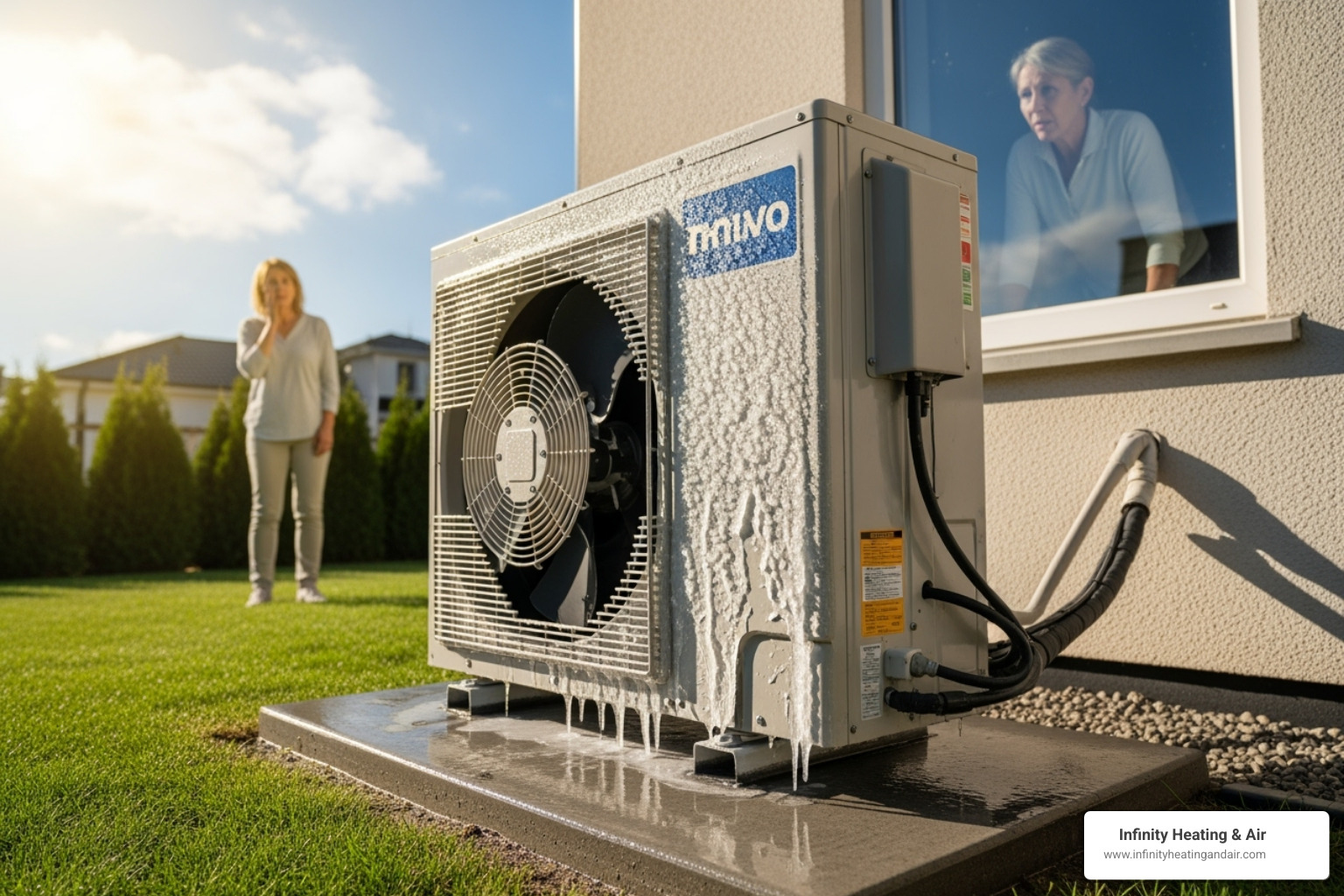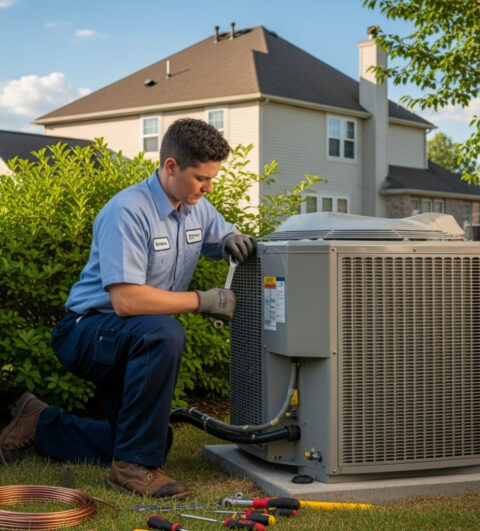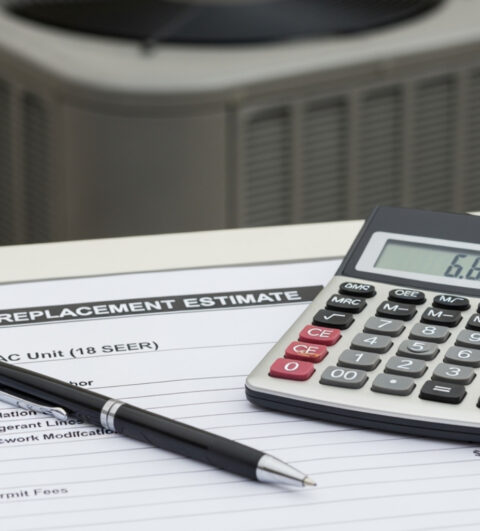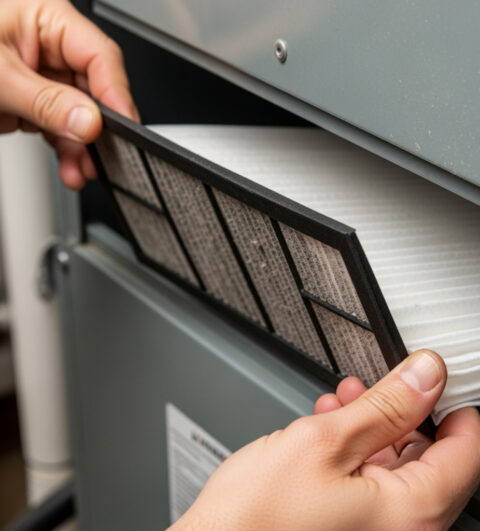Heat pump not cooling? Troubleshoot common issues from thermostat to frozen coils. Learn when to call pros for quick repairs.
When Your Heat Pump Fails to Beat the Summer Heat
Heat pump not cooling properly can turn your comfortable home into an uncomfortable sauna, especially during Northwest Washington’s surprisingly warm summer days. When you’re expecting that refreshing cool air and instead get warm or hot air blowing from your vents, it’s more than just inconvenient—it’s a sign that something’s wrong with your system.
Quick troubleshooting checklist for a heat pump not cooling:
- Check thermostat settings – Ensure it’s set to “Cool” and temperature is below room temp
- Inspect air filter – Replace if dirty or clogged
- Examine outdoor unit – Clear debris and check for ice buildup
- Listen for unusual sounds – Clicking or hissing may indicate component failure
- Check circuit breakers – Reset if tripped
- Call a professional – If basic steps don’t work or you find refrigerant leaks
The good news is that many cooling issues have simple DIY fixes. Incorrect thermostat settings, dirty air filters, or a blocked outdoor unit are common culprits behind a “broken” heat pump.
However, some issues like a stuck reversing valve, refrigerant leaks, or frozen evaporator coils require professional expertise and tools.
Don’t let a malfunctioning heat pump ruin your summer comfort. This guide walks you through troubleshooting, helping you identify what you can fix and when it’s time to call a professional.
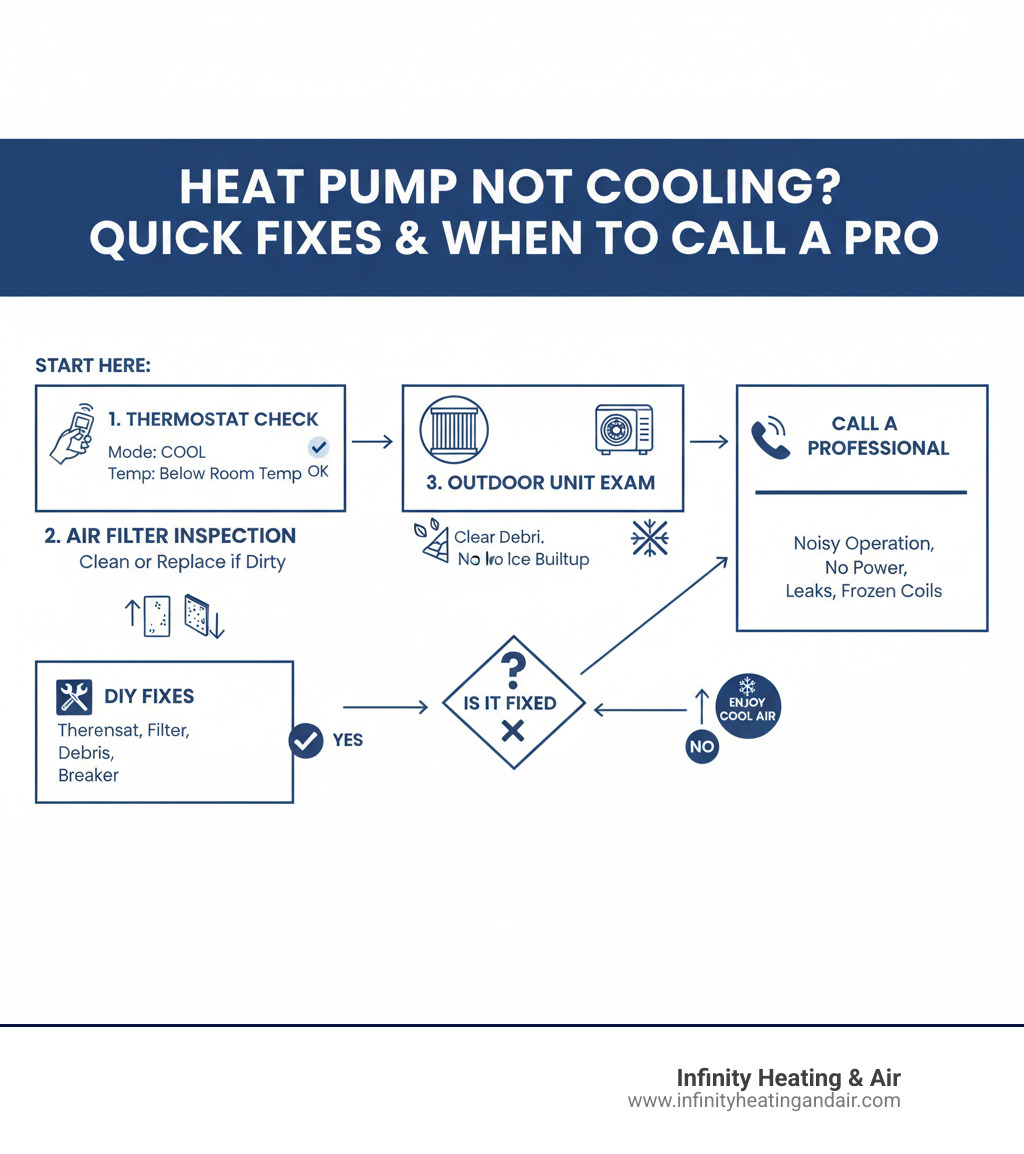
Your First Line of Defense: Simple Troubleshooting Steps
When your heat pump not cooling properly, don’t panic. Many cooling issues have simple solutions you can handle yourself. We’ll systematically check the most common culprits first.
These basic steps solve many heat pump issues and can prevent an unnecessary service call. Let’s walk through these simple fixes.
Check Your Thermostat Settings
Your thermostat is the brain of your HVAC system. If it sends the wrong signals, your heat pump will follow those instructions, which could mean blowing warm air on a hot day.
Start with the obvious: make sure your thermostat is set to “Cool” mode. It’s a common mistake to find thermostats accidentally switched to “Heat” or “Off.” If it’s on heat mode, your system is working as programmed, just not how you want it to.
Next, check your temperature setting. Your thermostat should be set at least 2-3 degrees below your current room temperature. If your home is 78°F and your thermostat is set to 80°F, your heat pump won’t turn on to cool.
The fan setting also matters. “Auto” is usually the best choice for cooling. If set to “On,” the fan runs constantly, circulating unconditioned air when the compressor is off, which can make it feel like your system isn’t working.
Smart thermostats can be trickier. Double-check any programmed schedules, vacation modes, or energy-saving settings that might be overriding your preferences. A software glitch or WiFi connectivity issue can also cause communication problems.
Can thermostat settings cause my heat pump to not cool? Absolutely – and it’s one of the easiest fixes you’ll find.
Inspect and Clean Your Air Filters
Think of your air filter as your heat pump’s lungs. When clogged with dust, pet hair, and other particles, your system can’t breathe well enough to cool your home effectively.
Dirty air filters create a domino effect. Restricted airflow forces your heat pump to work harder while delivering less cooling. Without steady air circulation, the evaporator coil can’t absorb heat properly and may even freeze up.
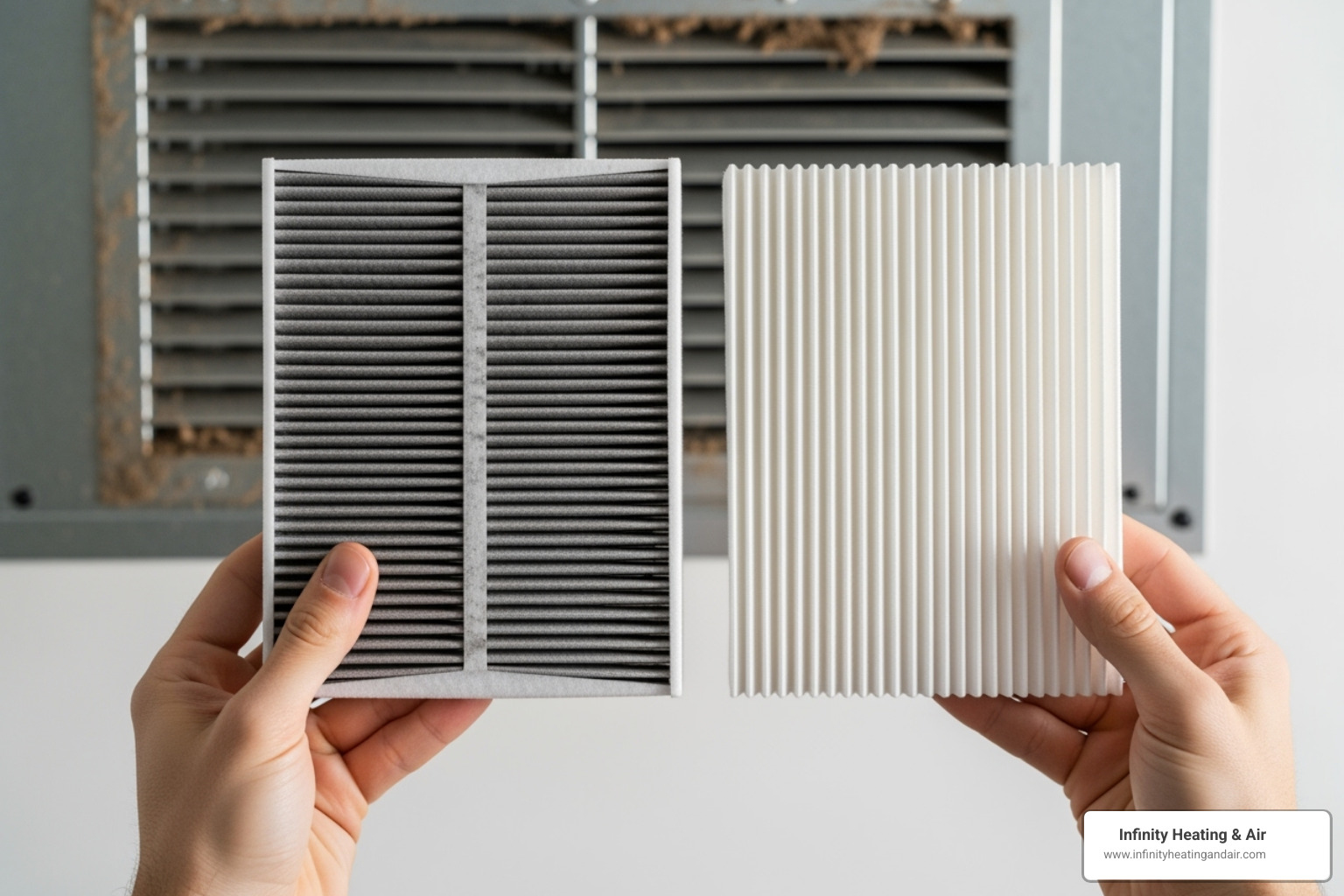
How to check your filter: Locate your filter, pull it out, and hold it up to a light. If you can’t see through it, or it looks grey and dusty, it’s time for a replacement. A clean filter should be white or light-colored.
We recommend checking your filter monthly, especially during peak cooling season in Northwest Washington. Most filters need changing every 1-3 months, depending on your household—homes with pets or allergies may need more frequent changes.
Clean air filters don’t just help your heat pump cool more effectively; they also improve indoor air quality and help your system run more efficiently. It’s a simple fix with big results.
Examine the Outdoor Unit
Your outdoor unit releases the heat absorbed from inside your home. Problems here can quickly shut down your cooling, so it’s worth a thorough once-over.
Start with the power. Check your electrical panel for a tripped circuit breaker for your heat pump. If you find one, reset it once. If it trips again, don’t keep resetting it—this signals a serious electrical issue that needs professional attention.
Clear away debris and obstructions. Northwest Washington’s greenery can get too close to outdoor units. Leaves, grass clippings, and overgrown shrubs can choke off airflow. Your outdoor unit needs at least two feet of clearance space on all sides to operate efficiently.
Look for ice buildup on the unit or refrigerant lines. While some frost in winter is normal, iced-over coils during cooling season is a red flag. This usually points to restricted airflow or refrigerant issues. If you spot ice, turn off your system immediately and let it thaw completely.
Here’s your outdoor unit inspection checklist:
- Power check: Verify the circuit breaker is on and hasn’t tripped
- Debris removal: Clear leaves, grass, and obstructions from around the unit
- Clearance verification: Ensure at least 2 feet of clear space on all sides
- Coil inspection: Look for dirt buildup on the condenser coils
- Ice detection: Check for any ice formation on coils or refrigerant lines
These simple steps catch many cooling problems before they become expensive repairs. If these checks don’t restore your comfort, it’s time to investigate more complex issues.
Why Is My Heat Pump Not Cooling? Common Culprits Explained
When the simple fixes don’t work, it’s time to dig deeper into what might be causing your heat pump not cooling issues. These problems are usually more complex and often need a professional’s touch, but understanding them helps you know what you’re dealing with.
The Reversing Valve is Stuck in Heat Mode
Unlike traditional air conditioners, heat pumps can both heat and cool. This is possible thanks to the reversing valve, a component that directs the flow of refrigerant.
This valve acts like a switch, changing the system between heating and cooling. When this valve gets stuck, your heat pump is stuck in the wrong mode.
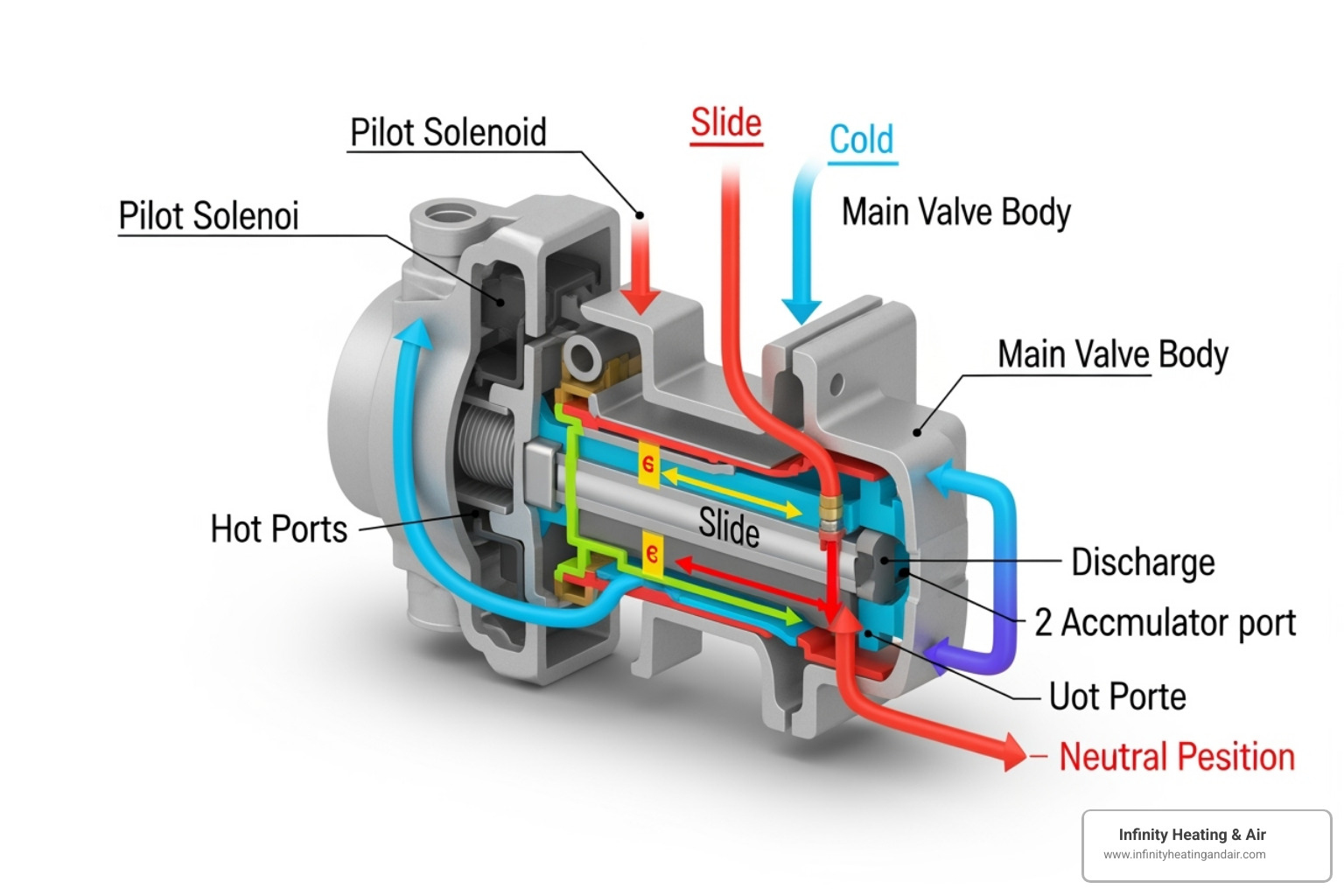
If the reversing valve is stuck in heating mode, your system will be blowing warm air even when set to cool. You might also hear clicking noises from the outdoor unit as the valve unsuccessfully tries to switch.
How does the reversing valve affect a heat pump’s cooling function? It’s critical. Without a functioning reversing valve, your heat pump is stuck in one mode. This isn’t a DIY repair; the valve requires professional diagnosis and replacement.
You Have a Refrigerant Leak
Refrigerant is the fluid that carries heat, making the cooling process possible. If your system doesn’t have enough refrigerant, it cannot cool your home effectively.
It’s important to know that refrigerant doesn’t get “used up.” It circulates in a closed system, so low levels mean there is a leak that needs to be found and fixed.
Hissing or bubbling sounds are often the first clue that refrigerant is escaping. Another telltale sign is reduced cooling ability—your heat pump runs constantly but never reaches the set temperature.
You might also notice frozen refrigerant lines, particularly on the larger, insulated copper line. This happens because low refrigerant pressure causes the remaining fluid to get extremely cold, freezing moisture from the air.
What role does refrigerant play in a heat pump’s cooling ability? It’s essential for heat transfer. Without proper refrigerant levels, your system cannot move heat from inside your home to the outside.
Refrigerant handling requires EPA certification, so this is a job for professionals. We can locate the leak, repair it, and recharge your system to the correct levels.
Your Evaporator Coils are Frozen
It might seem counterintuitive, but a frozen indoor coil is a common reason heat pumps stop cooling. When ice builds up on the evaporator coil, it creates a barrier that prevents the coil from absorbing heat from your home’s air. Instead of cool air, you’ll get warm or hot air from your vents.
The evaporator coil needs a steady stream of warm indoor air to work properly. When that airflow gets blocked, the coil gets too cold and starts to ice over. The most common culprit is a dirty air filter.
Low refrigerant levels can also cause coil freezing. When there isn’t enough refrigerant, the pressure drops, making the remaining refrigerant extremely cold. Blocked return air vents can have the same effect—if not enough air gets back to the indoor unit, the coil won’t get the warm air it needs.
If you find frozen coils, turn off your system at the thermostat and circuit breaker. Let the ice melt completely, which can take several hours. Never try to chip or scrape the ice off. While you wait, check and replace your air filter if it’s dirty.
Once thawed, you can try turning the system back on. If the coils freeze again, it’s a clear sign of an underlying problem that needs professional attention. Causes of frozen coils often involve refrigerant issues or mechanical problems that require proper diagnosis.
When to Stop Troubleshooting and Call a Professional
While some issues are simple fixes, many heat pump not cooling problems require a certified technician’s expertise. Attempting complex repairs yourself can be dangerous and may cause more damage to your system.
Knowing when to call for help is smart. Some repairs involve high voltage electricity, pressurized refrigerant, and intricate mechanical components that require specialized training and tools to handle safely.
Electrical Component Failure
Your heat pump is a sophisticated electrical machine. When its electrical components fail, the result can be poor cooling or a complete system shutdown. These problems require professional diagnosis and repair.
Capacitor issues are among the most common electrical failures. These components help start your compressor and fan motors. When a capacitor goes bad, you might hear a clicking sound as your outdoor unit tries to start but fails. Sometimes the fan will spin, but the compressor won’t, leaving you with no cooling.
Contactor problems can also be the culprit. The contactor is a switch that sends power to your compressor and outdoor fan. When it fails, these critical components won’t receive the power they need to operate.
Wiring faults can be tricky to diagnose. Loose connections, corroded wires, or damaged insulation can cause intermittent problems that are difficult to pinpoint without proper testing equipment.
A tripped breaker that won’t reset or trips repeatedly is especially concerning. This is a safety feature protecting your home from a dangerous electrical situation. Never keep resetting a breaker that trips multiple times, as this can damage equipment or cause a fire.
Blower motor failure is another frustrating issue. Your heat pump might be producing cool air, but if the blower motor isn’t working, that air isn’t going anywhere. You’ll hear the outdoor unit running but feel little to no airflow from your vents.
Refrigerant Leaks and Recharging
When it comes to refrigerant, this is definitely professional territory. Refrigerant is a regulated substance that requires EPA certification to handle legally and safely.
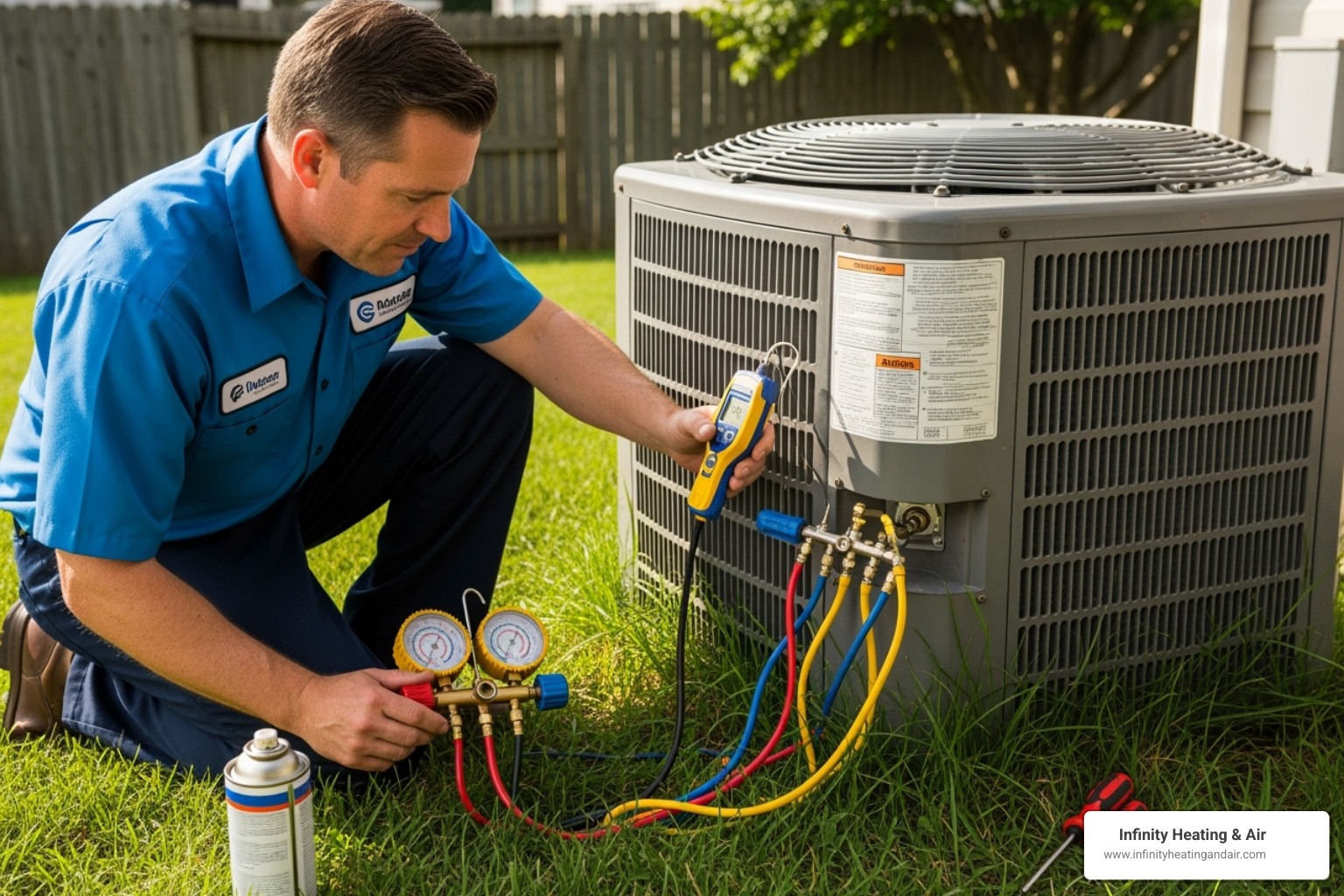
Low refrigerant levels almost always mean there’s a leak in your system. Refrigerant circulates in a closed loop and doesn’t get “used up.” If levels are low, simply adding more without finding and fixing the leak is only a temporary fix.
Signs of a refrigerant leak can be subtle. Your system might run longer to cool, or you might notice hissing or bubbling sounds from the indoor or outdoor unit. Ice on the refrigerant lines is another telltale sign.
The environmental and legal aspects of refrigerant work make this a clear case for professional help. A professional HVAC technician has the training, tools, and certification to locate leaks, repair them, and recharge your system to the exact specifications required for efficient operation.
Major Mechanical Problems
Some heat pump problems go beyond simple fixes and into major mechanical territory. These issues involve core components, and when they fail, it’s time to call in the cavalry.
Compressor failure is one of the most serious issues. The compressor is the heart of your system, circulating the refrigerant. When it fails, your system cannot cool at all. You might hear the outdoor unit trying to start, or it might run quietly but produce no cool air.
A broken reversing valve is another problem. This component allows your heat pump to switch between heating and cooling. When it fails, you might get warm air even when your thermostat is set to cool.
Fan motor issues can affect both indoor and outdoor units. A failed outdoor fan motor prevents the system from rejecting heat, leading to poor cooling. If the indoor blower motor fails, cool air can’t be circulated through your home.
These major mechanical problems require the expertise and specialized tools that only a trained HVAC professional possesses. At Infinity Heating & Air, we have the experience to diagnose these complex issues and provide lasting solutions. For more detailed information about our comprehensive services, check out our heat pump repair services.
Frequently Asked Questions about Heat Pump Cooling Issues
We get these questions a lot from homeowners across Northwest Washington, and honestly, they’re the ones that keep us busy during those surprisingly hot summer days. Let’s tackle the most common concerns we hear when your heat pump not cooling becomes the main topic of conversation at the dinner table.
Why is my heat pump running but not cooling the house?
This is probably the most frustrating scenario for any homeowner. You can hear your system humming along, doing what sounds like hard work, but your house feels like a sauna. It’s like having a car with the engine running but the wheels not turning—something’s disconnected in the process.
The most common culprit? A dirty air filter restricting airflow. When your filter is clogged with dust, pet hair, and all the microscopic stuff floating around your home, your heat pump can’t breathe properly. It’s working overtime but can’t move enough air to actually cool your space.
Low refrigerant due to a leak is another frequent cause. Think of refrigerant as the blood in your heat pump’s veins—without enough of it, the whole heat transfer process breaks down. Your system might sound like it’s running normally, but it’s essentially running on empty.
A frozen evaporator coil can also create this exact scenario. When the indoor coil ices up, it can’t absorb heat from your home’s air, even though the fans are still blowing. The result? Warm or even hot air coming from your vents when you’re desperately craving that cool relief.
If you’ve checked your filter and it’s clean, this is definitely a job for the professionals. There are too many variables at play, and trying to guess can lead you down an expensive rabbit hole.
How do I know if my heat pump’s reversing valve is bad?
The reversing valve is like the traffic director of your heat pump—it tells the refrigerant which direction to flow. When it’s working properly, you don’t even know it exists. When it’s not, well, that’s when things get interesting.
The most obvious red flag is when your heat pump works perfectly in one mode but fails in the other. If your system heated your home beautifully all winter but now blows warm air when you desperately need cooling, the reversing valve is likely stuck in heating mode. It’s like having a one-way street sign that won’t flip—traffic can only go one direction.
Listen for unusual sounds from your outdoor unit—specifically a distinct clicking or buzzing noise. This is often the sound of the reversing valve trying to switch modes but failing to complete the process. It’s the mechanical equivalent of a door handle that jiggles but won’t turn.
Sometimes homeowners think they have a thermostat problem when it’s actually the reversing valve. You set it to cool, but the system keeps heating because the valve can’t make the switch. This isn’t something you can fix with a screwdriver and good intentions—it requires professional diagnosis and repair.
Can I fix a frozen heat pump myself?
Here’s where we give you the good news and the reality check in one answer. Yes, you can handle the immediate problem, but no, you probably can’t fix the underlying cause.
Your first step is always to turn off the system—both at the thermostat and at the circuit breaker. This gives the ice time to melt naturally and safely. Never, and we mean never, try to chip away ice with tools or pour hot water on the coils. You’ll likely cause expensive damage that makes the original problem look like pocket change.
While the system is thawing, check and replace your air filter. Poor airflow is the number one cause of frozen coils, and a dirty filter is often the villain. This simple step might actually solve your problem if you catch it early enough.
However, if the unit refreezes after you restart it, that’s your cue to call us. Recurring ice buildup usually indicates deeper issues like a refrigerant leak, a failing blower motor, or other mechanical problems. These aren’t DIY territory—they require specialized tools, training, and often EPA certifications to handle safely.
The thawing process can take several hours, so be patient. Use this time to check those filters and maybe enjoy a cold beverage while you wait. But if the problem returns, don’t keep playing the freeze-and-thaw game. It’s time to bring in the experts who can identify and fix the root cause, ensuring your heat pump not cooling becomes a thing of the past.
Get Your Cool Back with Professional Help
A heat pump not cooling is more than an inconvenience; it disrupts your home’s comfort. While DIY troubleshooting can solve minor issues, problems like refrigerant leaks, electrical faults, and broken reversing valves require professional attention. Don’t let the heat win.
We understand how frustrating a broken heat pump is, especially on a warm Northwest Washington day. When your home feels more like a sauna than a sanctuary, a professional diagnosis is essential.
Professional HVAC technicians have the specialized tools and expertise to go beyond basic troubleshooting. When your heat pump is blowing warm air, we can quickly identify whether you’re dealing with a refrigerant leak, a faulty reversing valve, or electrical component failure. These aren’t issues to tackle yourself; they require proper training and equipment to repair safely.
The expert team at Infinity Heating & Air is here to diagnose and resolve your heat pump’s cooling woes, restoring the “endless comfort” you deserve. Our certified technicians understand Northwest Washington’s climate and can get your system back to peak performance. We serve Graham and the wider Western Washington area, committed to creating the comfortable environment your family needs.
Choosing Infinity Heating & Air means choosing a partner dedicated to your comfort and health. A properly functioning heat pump isn’t just about staying cool—it’s about creating an environment where your family can thrive.
Don’t suffer through another uncomfortably warm day. If your troubleshooting steps haven’t worked, or you suspect a more serious issue, it’s time to call the professionals. Contact Us today for expert heat pump repair diagnostics and service, and let us help you beat the heat with reliable, efficient cooling.

